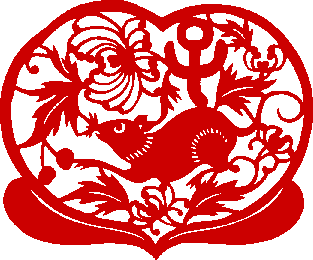Bryanna Clark Grogan’s Vegan Feast Kitchen/ 21st Century Table: The kitchen journal of a vegan food writer.. I'm on Facebook and Twitter (see links in sidebar at right).
Thursday, February 7, 2008
HAPPY YEAR OF THE RAT!


Image from ratical.org
NOTE: I FINALLY ORGANIZED THE RECIPE PAGE LINKS INTO CATEGORIES!
KUNG HEY FAH CHOY!* (*means “I wish you a prosperous New Year”)
This is my year! yes, I have to confess that I am a Rat! But:
"Being born a Rat is nothing to be ashamed of. In China, the Rat is respected and considered a courageous, enterprising person. It is deemed an honor to be born in the Year of the Rat and it is considered a privilege to be associated with a Rat. Rats know exactly where to find solutions and can take care of themselves and others without problems. They use their instinctive sense of observation to help others in times of need and are among the most fit of all the Animal signs to survive most any situation."
More about Rat personality and The Year of the Rat:
http://www.usbridalguide.com/special/chinesehoroscopes/Rat.htm
http://www.squidoo.com/2008YearoftheRat
Anyway, it is a time to party BIG TIME!
(We usually call this holiday "Chinese New Year", but actually, it is probably more accurate to say “the Lunar New Year”, because many Asian communities besides the Chinese celebrate it—- the Vietnamese, Korean, Laotian, Cambodian, and Tibetan people, particularly. Read more about the Lunar calendar here.)
It is actually two big celebrations in one—- New Year’s Day and everyone’s birthday! According to Chinese tradition, everyone adds one year to their age on New Year’s Day. It is also an important family get-together event, because one must try to see every family member face-to-face! Since Chinese families used to be large, and perhaps spread far apart, the New Year’s festivities used to last for a month, in order to see everyone! Now they generally last for about a week.
On New Year’s Eve there is a huge family feast for as many members of the family as possible. The children get to stay awake all night, because the Chinese believe that the longer the children stay awake, the longer their parents will live! (Better not let that get around!) Red is a good luck color, so you will see red everywhere. The table for the feast is set with a red cloth and red candles. And, surprise! THE NEW YEAR'S EVE MEAL IS A VEGETARIAN FEAST! No meat is served because harm would have to be caused to obtain meat and this would be bad luck (too bad this doesn’t extend to the rest of the year!).

Some Chinese New Year food customs:
Oranges and apples are the usual fruit, since apples are symbols of good luck and apples and oranges are both round (another lucky symbol) and are red and orange— colors of joy! Kumquats are another round, orange fruit that symbolize “golden luck”.
Fresh bean curd or tofu is not included as it is white and unlucky for New Year as the color signifies death and misfortune. Candied lotus seeds symbolize more sons; watermelon seeds more children. These days, gold-wrapped chocolate coins symbolize wealth. Candied lotus root is for endless friendship, and coconut for good relations between fathers and sons. Sweet things are for the sweetness of life; dumplings represent wealth, and romaine lettuce is for prosperity.
In other Asian communities that celebrate at the same time, many customs, such as cleaning the house, visiting, exchanging gifts of food and red envelopes of money, games of chance, fireworks, new clothes, etc.. are the same. Tibetans eat a special nine dumpling soup with fortune-telling tokens in them.
In Vietnamese communities, there is a two-day holiday called Tet. Homes are decorated with peach blossoms, which represent peace and luck. During the two days of celebration no real cooking is done-- snack foods (such as steamed rice cakes) and sweets are eaten. But on the day after the official celebration there is usually a big family meal with traditional foods such as spring rolls.
If you have a party, to find a book or website on Chinese horoscopes so that your guests can find their signs and predict their luck in the year ahead!
Read more about this holiday here.

A YUMMY DISH FOR ANY TIME OF THE YEAR
Below is a recipe that is one of DH's favorites, and very easy to make. I give you several options for the protein part of the dish, but our favorite is textured soy protein chunks. Now if you are under the impression that textured soy protein is not good for you, read on:
Actually, textured soy protein is simply de-fatted soy flour cooked with water, then extruded through machinery to make granules, chunks, cutlets, etc., then dehydrated.
Organic and/or solvent-free textured soy protein (TVP®, BTW, is the same thing, but it is a registered brand name, and is also the same thing as "textured vegetable protein" or TSP), is available!
(Updated Feb. 2014)
Bob’s Red Mill: Organic and/or solvent-free
textured soy protein (they call it “TSP), the
granulated version only:
http://www.bobs-redmill.com
Frontier Co-op: has unflavored organic
textured soy protein in 2 different sizes:
1/4-inch pieces (similar to granules) and
1/2-inch pieces (small chunk):
http://www.frontiercoop.com
The Mail-Order Catalog: carries a granulated
version (“small bits”) and a chunk version (“Medium bits”):
http://www.healthy-eating.com/category/soyfoods_organic_soy
So-Soya Slices is another product I like. (Pictured in the dish below.) If you are Canadian, you may be able to buy them from a Bulk Barn. They are GMO-free and can be purchased online at http://www.sosoyafoods.com/shop/
I also like a product called Soy Curls
As for commercial textured soy protein products, Nexsoy makes a commercial organic textured soy protein that manufacturers use for organic meat substitutes.
Here is what they say about their product:
"The unique Nexsoy® process is totally solvent-free, yielding a product line that is free of the "soy" taste that some consumers find unpalatable, leaving you free to work on developing your flavor, not masking agents. Traditionally, most soy ingredients are produced using a chemical solvent called hexane. This method is believed to be responsible for the "grassy" or "beany" flavor that has historically slowed the acceptance soyfoods. The Nexsoy® processing method is entirely mechanical and requires no chemicals such as hexane. This process is responsible for very neutral-tasting naturally-produced soy ingredients that can be used by food manufacturers without negatively impacting the flavor of their product."

Printable Recipe
BRYANNA'S CANTONESE-STYLE CRISPY "PORK" WITH SWEET AND SOUR SAUCE
This recipe, from my book "Authentic Chinese Cuisine for the Contemporary Kitchen
NO-FRY OPTION: Dredge your chunks is the starch as usual. Spread the chunks on a large cookie sheet sprayed with oil from an oil spray bottle/mister. Spray the chunks with a little oil. Place about 6 inches under your oven's broiler. Broil on high for several minutes (watching carefully so they don't scorch or burn) until they are crispy on top. Turn them over and broil briefly until the 2nd side is crispy. Remove from the broiler and proceed with the recipe.
2-3 cups reconstituted textured soy protein chunks (Cooking Tips below for how to reconstitute)
(See text above about organic textured soy protein chunks)
OR small chunks of seitan
OR reconstituted Soy Curls®
Cornstarch or water chestnut flour
oil
VEGETABLES:
1 Tbs oil
1 large onion, cut into 6ths, layers separated
1 large red bell pepper, seeded and cut into 1" squares
1/2 cup sliced water chestnuts (preferably fresh)
OR 1 large stalk celery, sliced 1/4" thick
1/4 cup frozen petit pois (baby peas) thawed in hot water and drained
1 tsp grated fresh ginger
1 clove garlic, chopped
COOKING SAUCE:
3 Tbs tomato sauce (or 1 and 1/2 Tbs EACH water and tomato paste)
2 Tbs rice vinegar, plain (or substitute cider vinegar or white wine vinegar)
2 Tbs light organic unbleached sugar
1 Tbs soy sauce
1 Tbs dry sherry or Chinese rice wine
3/4 cup water
THICKENER:
1 Tbs cornstarch dissolved in 2 Tbs cold water
Roll the reconstituted soy protein (or seitan) chunks or Soy Curls® in cornstarch or water chestnut flour, shaking off the excess starch. Heat about a cup of oil in a large skillet, wok to 375°F.
Fry the chunks in several batches in the hot oil until they are golden and crispy, then drain them on paper towels on a cookie sheet. Keep them warm in a 200°F oven.
Heat a large wok, stir-fry pan
Servings: 4
Nutrition Facts
Nutrition (per serving): 352.4 calories; 41% calories from fat; 17.3g total fat; 0.0mg cholesterol; 172.7mg sodium; 857.5mg potassium; 39.7g carbohydrates; 2.5g fiber; 11.4g sugar; 37.1g net carbs; 15.9g protein; 8.0 points.
Cooking Tips
HOW TO RECONSTITUTE TEXTURED SOY PROTEIN CHUNKS
Reconstitute the textured soy protein chunks by simmering 1 and 1/2 cups dry chunks in 3 cups water with 3 Tbs soy sauce, 3 Tbs ketchup or tomato paste, and 1 Tbs nutritional yeast flakes
Happy New Year!

Subscribe to:
Post Comments (Atom)
8 comments:
Kung hey fah choi! Thank you so much for all of the recipes and kitchen wisdom that you share.
Your recipe sounds delicious, and what a wonderful tip about frying in a wok! Thank you!
Kung Hay Fat Choi! Bryanna! I am a rat also so this is my year. So we are 2 vegan rats...he he...
I love the 'pork' dish! Last time I made it with veggie ribs from the box. I made it chunks and baked till crispy. It's quite good. Where can I get Nexsoy, I wonder? I'll email the company. Thanks for the info!
I'm a Rat!! I remember hating that when I was younger & would see my birth year matched up with an "ugly rat" on the menus at Chinese restaurants... I always wanted to be a Monkey. :) Now I am happy to embrace the rat.
That crispy "pork" dish looks INCREDIBLE! That is definitely going on my list of dishes to make soon! Thank you!!
Yum - Chinese stir-fries! Who can ever tire of those! You prompted me to make a variation of this one with pineapple, red pepper and broccoli. Mmmm ...
AHH!!! Love you Bryanna!! THanks so much for sorting the recipes out!! They're still a long long list for each category...sigh. You've churned out so much yumyum..
Gung hay fat choy! Wishing you an awesome Year of the Rat!
Thanks for the info on tvp. I always wondered about whether or not it was good for you and I've got to try these soy curls. It all looks so delicious!
Hi. I made this today and it was really really good. I used seitan and everyone around the table loved it. It will be made again, I'm sure :) Thanks!
Post a Comment